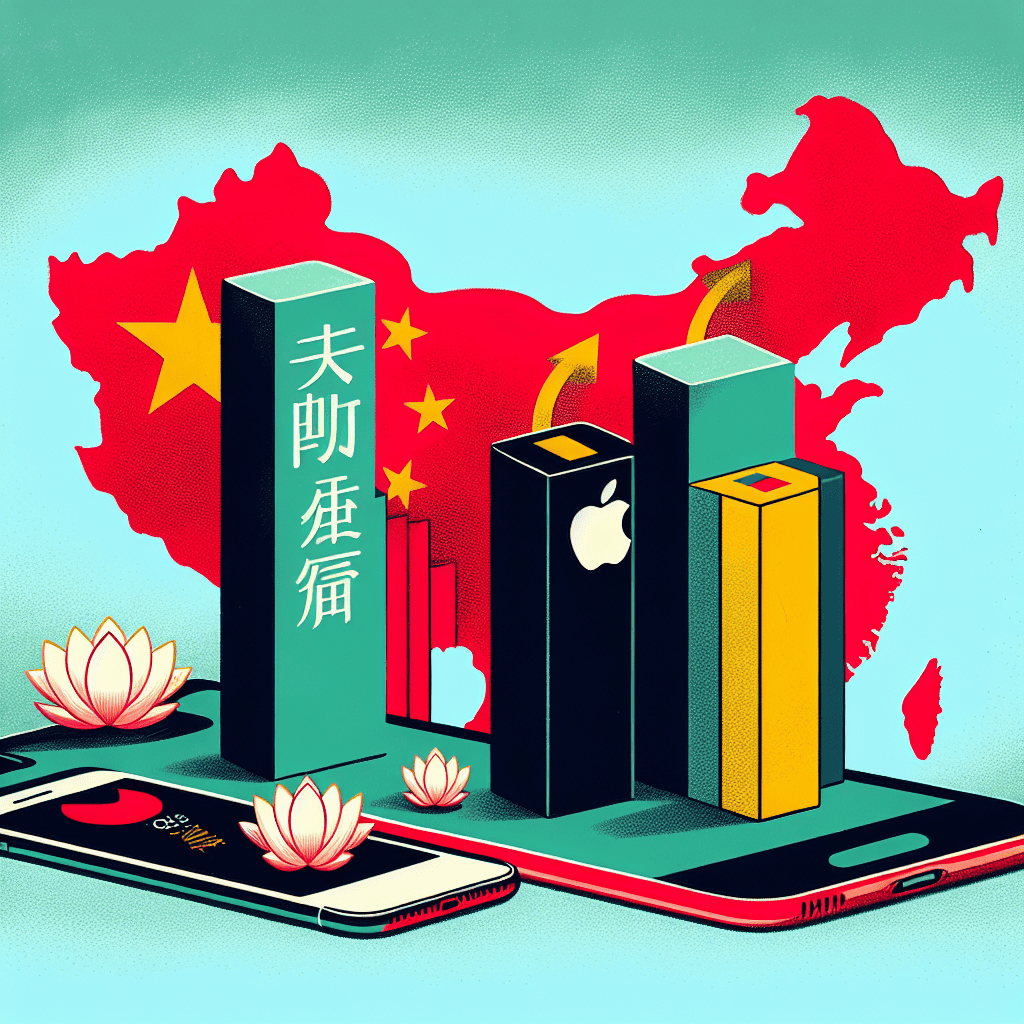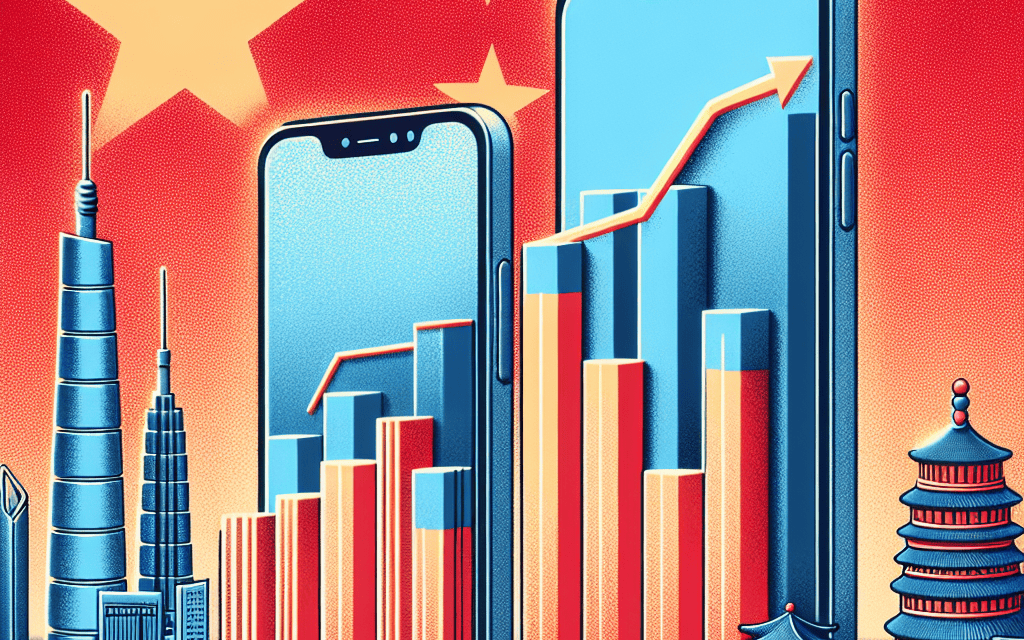“Apple’s Dip, Huawei’s Rise: A Shift in China’s Smartphone Tide.”
Introduction
In the third quarter of 2023, Apple’s smartphone sales in China experienced a notable decline, coinciding with a significant surge in sales for Huawei. This shift in the competitive landscape highlights the dynamic nature of the Chinese smartphone market, where consumer preferences and brand loyalties can rapidly evolve. Huawei’s resurgence, following a period of challenges due to international trade restrictions, underscores its resilience and ability to innovate, capturing the attention of Chinese consumers. Meanwhile, Apple’s dip in sales may reflect increased competition and changing market dynamics, prompting the tech giant to reassess its strategies in one of its most crucial markets.
Analysis Of Apple’s Q3 Performance In China: Factors Behind The Decline
In the third quarter of 2023, Apple’s performance in the Chinese smartphone market experienced a notable decline, a development that has captured the attention of industry analysts and investors alike. This downturn in sales is particularly significant given the competitive landscape in China, where Apple has traditionally held a strong position. Several factors have contributed to this decline, with the resurgence of Huawei as a formidable competitor being one of the most prominent.
To begin with, Huawei’s resurgence in the Chinese market has been nothing short of remarkable. After facing significant challenges due to U.S. sanctions, Huawei has managed to regain its footing by focusing on innovation and leveraging its strong brand loyalty within China. The launch of new models equipped with advanced features and competitive pricing has resonated well with Chinese consumers, who have shown a renewed interest in supporting domestic brands. This shift in consumer preference has inevitably impacted Apple’s market share, as Huawei’s offerings present a compelling alternative to the iPhone.
Moreover, the economic environment in China has also played a role in shaping consumer behavior. With the Chinese economy experiencing fluctuations, consumers have become more price-sensitive, seeking value for money in their purchases. Apple’s premium pricing strategy, while effective in other markets, faces challenges in China where cost-conscious consumers are exploring more affordable options. This economic backdrop has provided an opportunity for Huawei and other local brands to capture a larger share of the market by offering high-quality devices at more accessible price points.
In addition to economic factors, technological advancements have also influenced the competitive dynamics in the Chinese smartphone market. Huawei’s focus on developing its own ecosystem, including the HarmonyOS operating system, has allowed it to differentiate itself from competitors. This strategic move not only reduces Huawei’s reliance on foreign technology but also appeals to nationalistic sentiments among Chinese consumers. As a result, Huawei’s ability to offer a seamless and integrated user experience has become a significant selling point, further challenging Apple’s dominance.
Furthermore, Apple’s own strategic decisions have contributed to its declining sales in China. While the company has made efforts to localize its offerings and cater to Chinese consumers, it faces the challenge of balancing global brand consistency with regional preferences. The introduction of new features and models that may not fully align with the specific needs and desires of Chinese consumers can lead to a disconnect, affecting sales performance. Additionally, Apple’s supply chain disruptions and production challenges have also impacted its ability to meet demand, further exacerbating the situation.
Despite these challenges, it is important to note that Apple remains a strong player in the Chinese market. The brand’s reputation for quality and innovation continues to attract a loyal customer base. However, to regain its competitive edge, Apple may need to reassess its strategies, focusing on enhancing its value proposition and addressing the unique preferences of Chinese consumers. This could involve exploring partnerships with local companies, investing in localized marketing campaigns, and potentially adjusting pricing strategies to better align with market conditions.
In conclusion, Apple’s decline in Q3 smartphone sales in China can be attributed to a combination of factors, including Huawei’s resurgence, economic conditions, technological advancements, and strategic decisions. As the competitive landscape continues to evolve, Apple will need to navigate these challenges carefully to maintain its position in one of the world’s most important smartphone markets.
Huawei’s Resurgence: How It Impacted Apple’s Market Share In China
In the third quarter of 2023, the Chinese smartphone market witnessed a significant shift as Huawei’s resurgence posed a formidable challenge to Apple’s market share. This development marked a pivotal moment in the ongoing competition between these two tech giants, with Huawei’s strategic maneuvers and technological advancements playing a crucial role in reshaping the landscape. As Apple experienced a decline in its smartphone sales in China, it became evident that Huawei’s resurgence was not merely a temporary phenomenon but a well-orchestrated comeback.
To understand the dynamics at play, it is essential to examine the factors contributing to Huawei’s resurgence. Following a period of adversity due to U.S. sanctions, Huawei demonstrated remarkable resilience by focusing on innovation and self-reliance. The company invested heavily in research and development, leading to the creation of its proprietary HarmonyOS and advanced chipsets. These technological advancements allowed Huawei to regain consumer confidence and reestablish its position in the market. Moreover, Huawei’s ability to leverage its extensive distribution network and strong brand loyalty further bolstered its resurgence.
In contrast, Apple’s decline in China during the same period can be attributed to several interrelated factors. While Apple has consistently maintained a strong brand presence and a loyal customer base, the competitive landscape in China has become increasingly challenging. Huawei’s resurgence, coupled with the growing popularity of other domestic brands, intensified the competition for market share. Additionally, economic factors, such as fluctuations in consumer spending and changing preferences, played a role in shaping the purchasing decisions of Chinese consumers.
Furthermore, Huawei’s strategic focus on catering to the specific needs and preferences of Chinese consumers proved to be a decisive factor in its resurgence. By offering a diverse range of products across various price segments, Huawei effectively captured a broad spectrum of the market. This approach allowed the company to appeal to both budget-conscious consumers and those seeking premium devices, thereby expanding its customer base. In contrast, Apple’s premium pricing strategy, while successful in other regions, faced challenges in a market where price sensitivity is a significant consideration.
As Huawei’s market share surged, it became evident that the company’s resurgence was not merely a result of competitive pricing but also a testament to its commitment to innovation. Huawei’s emphasis on cutting-edge technology, such as 5G capabilities and advanced camera systems, resonated with tech-savvy consumers who prioritize performance and features. This focus on innovation not only differentiated Huawei from its competitors but also positioned it as a leader in the rapidly evolving smartphone industry.
In conclusion, the third quarter of 2023 marked a turning point in the Chinese smartphone market as Huawei’s resurgence significantly impacted Apple’s market share. Through a combination of strategic innovation, consumer-centric approaches, and effective distribution, Huawei successfully reestablished itself as a formidable competitor. Meanwhile, Apple’s decline highlighted the challenges of navigating an increasingly competitive landscape and adapting to evolving consumer preferences. As the competition between these two tech giants continues to unfold, it remains to be seen how Apple will respond to Huawei’s resurgence and what strategies it will employ to regain its footing in the Chinese market. Ultimately, this dynamic interplay between innovation, competition, and consumer preferences will shape the future trajectory of the smartphone industry in China and beyond.
Consumer Preferences: Why Chinese Buyers Are Choosing Huawei Over Apple
In the third quarter of 2023, Apple’s smartphone sales in China experienced a notable decline, a trend that coincided with a significant surge in Huawei’s market performance. This shift in consumer preferences has sparked considerable interest and analysis, as it reflects broader dynamics within the Chinese smartphone market. Understanding why Chinese buyers are increasingly choosing Huawei over Apple requires an examination of several key factors, including national sentiment, technological advancements, and pricing strategies.
To begin with, national sentiment plays a crucial role in shaping consumer behavior in China. In recent years, there has been a growing sense of national pride and support for domestic brands among Chinese consumers. Huawei, as a homegrown company, has successfully capitalized on this sentiment by positioning itself as a symbol of Chinese innovation and resilience. This patriotic appeal is particularly potent in the context of ongoing geopolitical tensions, where supporting a domestic brand like Huawei can be seen as an act of national solidarity. Consequently, many Chinese consumers are opting for Huawei smartphones as a way to express their support for local industry and technology.
Moreover, Huawei’s technological advancements have significantly contributed to its appeal. The company has made substantial investments in research and development, resulting in cutting-edge features and capabilities that rival those of Apple. For instance, Huawei’s latest models boast impressive camera technology, long battery life, and advanced artificial intelligence functionalities. These innovations have not only enhanced the user experience but have also positioned Huawei as a leader in smartphone technology. As a result, tech-savvy consumers who prioritize the latest features and performance are increasingly drawn to Huawei’s offerings.
In addition to technological prowess, pricing strategies have also played a pivotal role in influencing consumer preferences. Huawei has adopted a more flexible pricing strategy compared to Apple, offering a wide range of models that cater to different budget segments. This approach has allowed Huawei to capture a broader audience, from budget-conscious consumers to those seeking premium devices. In contrast, Apple’s pricing strategy has traditionally focused on the premium segment, which may limit its appeal in a market where price sensitivity is a significant factor. By providing high-quality smartphones at competitive prices, Huawei has effectively positioned itself as a more accessible and attractive option for a diverse range of consumers.
Furthermore, Huawei’s strong distribution network and localized marketing efforts have bolstered its market presence in China. The company has established an extensive retail network across the country, ensuring that its products are readily available to consumers. Additionally, Huawei’s marketing campaigns are tailored to resonate with local audiences, emphasizing features and benefits that align with Chinese consumer preferences. This localized approach has enabled Huawei to build strong brand loyalty and maintain a competitive edge over international rivals like Apple.
In conclusion, the decline in Apple’s Q3 smartphone sales in China, juxtaposed with Huawei’s surge, can be attributed to a combination of national sentiment, technological advancements, pricing strategies, and effective market positioning. As Chinese consumers increasingly prioritize domestic brands that offer cutting-edge technology and value for money, Huawei has emerged as a formidable competitor in the smartphone market. This shift in consumer preferences underscores the importance of understanding local market dynamics and adapting strategies to meet the evolving needs and expectations of consumers. As the landscape continues to evolve, both Apple and Huawei will need to navigate these complexities to maintain and grow their market share in China.
Strategic Missteps: Lessons Apple Can Learn From Its Q3 Sales Decline In China

In the third quarter of 2023, Apple experienced a notable decline in its smartphone sales within the Chinese market, a development that has sparked considerable discussion among industry analysts and stakeholders. This downturn is particularly significant given the concurrent surge in sales by Huawei, a key competitor in the region. Understanding the factors contributing to Apple’s performance in China during this period is crucial for identifying strategic missteps and deriving valuable lessons for future endeavors.
One of the primary factors influencing Apple’s sales decline is the intensifying competition from local brands, particularly Huawei. Huawei’s resurgence in the Chinese market has been marked by its ability to leverage advanced technology and cater to local consumer preferences. The introduction of new models equipped with cutting-edge features, such as enhanced camera capabilities and 5G connectivity, has resonated well with Chinese consumers. In contrast, Apple’s offerings during this period did not exhibit significant innovation or differentiation, which may have contributed to a perception of stagnation among potential buyers.
Moreover, Apple’s pricing strategy in China has also played a role in its sales performance. The premium pricing of iPhones, while reflective of their high-quality build and brand prestige, may have alienated price-sensitive consumers in a market where cost-effective alternatives are readily available. Huawei, on the other hand, has successfully positioned its products as offering superior value for money, thereby attracting a broader demographic. This pricing disparity highlights the importance of aligning product pricing with market expectations and consumer purchasing power.
In addition to competitive pressures and pricing challenges, Apple’s supply chain dynamics have also impacted its sales in China. The global semiconductor shortage has affected production timelines and inventory levels, leading to delays in product availability. While this issue is not unique to Apple, the company’s reliance on a complex global supply chain may have exacerbated the situation. In contrast, Huawei’s more localized supply chain operations have enabled it to navigate these disruptions more effectively, ensuring a steady flow of products to meet consumer demand.
Furthermore, Apple’s marketing and localization strategies in China warrant examination. While Apple has a strong global brand presence, its marketing efforts in China may not have fully resonated with local cultural nuances and consumer preferences. Huawei’s marketing campaigns, on the other hand, have been adept at tapping into national pride and leveraging local influencers, thereby strengthening its brand affinity among Chinese consumers. This underscores the importance of tailoring marketing strategies to align with regional cultural contexts and consumer sentiments.
In light of these challenges, Apple can glean several lessons from its Q3 sales decline in China. Firstly, the company must prioritize innovation and differentiation in its product offerings to maintain its competitive edge. Secondly, a reassessment of its pricing strategy could help Apple capture a larger share of the market by appealing to a wider range of consumers. Additionally, enhancing supply chain resilience through diversification and localization could mitigate the impact of global disruptions. Finally, refining marketing strategies to better align with local cultural dynamics could enhance brand resonance and consumer engagement.
In conclusion, Apple’s Q3 sales decline in China serves as a valuable case study in strategic adaptation and market responsiveness. By addressing these key areas, Apple can strengthen its position in the Chinese market and ensure sustained growth in the face of evolving competitive landscapes.
The Role Of Innovation: How Huawei’s New Technologies Are Attracting Chinese Consumers
In the rapidly evolving landscape of smartphone technology, innovation remains a critical driver of consumer preference and market dynamics. This is particularly evident in the recent shifts observed in China’s smartphone market, where Apple’s Q3 sales have experienced a notable decline, juxtaposed against a surge in Huawei’s performance. Understanding the role of innovation in this context provides valuable insights into how technological advancements can influence consumer behavior and market share.
Huawei’s resurgence in the Chinese market can be largely attributed to its strategic focus on integrating cutting-edge technologies into its latest smartphone offerings. The company’s commitment to innovation is exemplified by its development of advanced features that resonate with the preferences of Chinese consumers. For instance, Huawei’s emphasis on enhancing camera capabilities, battery life, and 5G connectivity has positioned its devices as attractive options for tech-savvy users seeking high-performance smartphones. These technological advancements not only meet the practical needs of consumers but also align with the growing demand for devices that support a digital lifestyle.
Moreover, Huawei’s investment in research and development has enabled it to introduce proprietary technologies that differentiate its products from competitors. The introduction of HarmonyOS, Huawei’s own operating system, is a testament to the company’s innovative prowess. This operating system offers a seamless and integrated user experience across various devices, appealing to consumers who value ecosystem connectivity. By creating a unique software environment, Huawei has managed to cultivate brand loyalty and attract a segment of consumers who prioritize technological integration and user experience.
In contrast, Apple’s recent decline in China’s smartphone market can be partially attributed to its slower pace of innovation in certain areas that are currently prioritized by Chinese consumers. While Apple continues to be a leader in design and brand prestige, its incremental updates in hardware and software may not be sufficient to capture the attention of a market that is increasingly driven by rapid technological advancements. The competitive landscape in China demands not only brand recognition but also tangible innovations that address the specific needs and preferences of local consumers.
Furthermore, Huawei’s ability to capitalize on nationalistic sentiments has also played a role in its market resurgence. In recent years, there has been a growing trend among Chinese consumers to support domestic brands, particularly in the face of geopolitical tensions. Huawei, as a prominent Chinese company, has benefited from this sentiment, which has translated into increased consumer loyalty and market share. This nationalistic inclination, combined with Huawei’s technological innovations, has created a compelling value proposition for Chinese consumers.
In conclusion, the contrasting fortunes of Apple and Huawei in China’s smartphone market underscore the pivotal role of innovation in shaping consumer preferences and market dynamics. Huawei’s strategic focus on integrating advanced technologies and creating a unique user experience has resonated with Chinese consumers, leading to its recent surge in sales. Meanwhile, Apple’s decline highlights the challenges faced by global brands in adapting to the rapidly changing technological landscape and consumer expectations in China. As the market continues to evolve, the ability to innovate and align with local consumer preferences will remain crucial for companies seeking to maintain and expand their presence in this competitive arena.
Market Dynamics: Understanding The Competitive Landscape In China’s Smartphone Industry
In the ever-evolving landscape of China’s smartphone industry, the third quarter of 2023 has presented a fascinating shift in market dynamics, marked by a notable decline in Apple’s sales and a concurrent surge by Huawei. This development underscores the competitive nature of the industry, where consumer preferences and technological advancements continuously reshape the market. Apple’s recent performance in China, a critical market for the tech giant, has been less than stellar. The decline in sales can be attributed to several factors, including intensified competition and changing consumer expectations. Despite the brand’s strong global presence and reputation for innovation, Apple faces challenges in appealing to Chinese consumers who are increasingly drawn to local brands that offer competitive pricing and features tailored to their needs.
Transitioning to the other side of the spectrum, Huawei’s resurgence in the Chinese market is a testament to its strategic adaptability and deep understanding of local consumer demands. After facing significant setbacks due to international trade restrictions, Huawei has managed to regain its footing by focusing on its core strengths and leveraging its extensive research and development capabilities. The company’s emphasis on 5G technology and its ability to offer high-quality devices at competitive prices have resonated well with Chinese consumers, contributing to its impressive sales growth in the third quarter.
Moreover, Huawei’s success can also be attributed to its strong brand loyalty and the nationalistic sentiment among Chinese consumers, who are increasingly inclined to support domestic brands. This sentiment has been further amplified by geopolitical tensions, which have encouraged consumers to rally behind homegrown companies. As a result, Huawei has not only regained market share but also strengthened its position as a formidable competitor in the Chinese smartphone industry.
In contrast, Apple’s challenges in China highlight the importance of understanding and adapting to local market conditions. While the company continues to innovate and introduce new products, it must also address the unique preferences and expectations of Chinese consumers. This includes offering devices that cater to local tastes, such as larger screens and enhanced camera capabilities, as well as competitive pricing strategies that align with the purchasing power of the average consumer.
Furthermore, Apple’s ecosystem, which has been a significant driver of its global success, may not hold the same appeal in China, where consumers have a plethora of options for apps and services that are tailored to their specific needs. This necessitates a more localized approach to marketing and product development, ensuring that Apple’s offerings resonate with the target audience.
In conclusion, the third quarter of 2023 has underscored the dynamic and competitive nature of China’s smartphone industry. While Apple faces challenges in maintaining its market share, Huawei’s resurgence highlights the potential for domestic brands to capitalize on local consumer preferences and geopolitical factors. As the industry continues to evolve, companies must remain agile and responsive to the shifting landscape, leveraging their strengths and addressing their weaknesses to succeed in this highly competitive market. The interplay between global giants and local champions will undoubtedly shape the future of China’s smartphone industry, offering valuable insights into the broader trends and forces at play in the global technology sector.
Future Outlook: Can Apple Regain Its Foothold In The Chinese Market?
In the third quarter of 2023, Apple’s smartphone sales in China experienced a notable decline, a development that has raised questions about the company’s future prospects in one of its most crucial markets. This downturn coincides with a remarkable resurgence by Huawei, a domestic competitor that has managed to capture the attention and loyalty of Chinese consumers. As Apple navigates this challenging landscape, the question arises: can the tech giant regain its foothold in the Chinese market?
To understand the dynamics at play, it is essential to consider the factors contributing to Apple’s recent struggles in China. One significant element is the intensifying competition from local brands, particularly Huawei. After facing setbacks due to U.S. sanctions, Huawei has made a strong comeback, leveraging its deep understanding of the local market and consumer preferences. By focusing on innovative features and competitive pricing, Huawei has successfully attracted a substantial portion of the Chinese consumer base, which has traditionally been a stronghold for Apple.
Moreover, the Chinese government’s push for technological self-reliance has further bolstered domestic brands. This nationalistic sentiment has encouraged consumers to support homegrown companies, thereby impacting Apple’s market share. Additionally, the economic climate in China has shifted, with consumers becoming more price-sensitive amid economic uncertainties. This has led to a preference for more affordable options, which local brands are well-positioned to provide.
Despite these challenges, Apple remains a formidable player with several strategies at its disposal to regain momentum in China. One potential avenue is to enhance its localization efforts. By tailoring products and services to better align with Chinese consumer preferences, Apple can strengthen its appeal. This could involve introducing features that cater specifically to the Chinese market or collaborating with local developers to create region-specific applications.
Furthermore, Apple’s brand reputation for quality and innovation continues to be a significant asset. By emphasizing these strengths, Apple can differentiate itself from competitors and maintain its status as a premium brand. Investing in research and development to introduce cutting-edge technologies and features that resonate with Chinese consumers could also help Apple regain its competitive edge.
In addition to product innovation, Apple’s retail strategy in China could play a crucial role in its recovery. Expanding its physical presence in key cities and enhancing the customer experience in its stores can foster stronger connections with consumers. Moreover, leveraging online platforms and e-commerce channels can help Apple reach a broader audience, especially in a market where digital engagement is rapidly growing.
Another critical aspect of Apple’s strategy should be its approach to pricing. While maintaining its premium brand image, Apple could explore offering more diverse pricing options to cater to a wider range of consumers. This could involve introducing more affordable models or implementing flexible financing options to make its products more accessible.
In conclusion, while Apple’s Q3 decline in China presents significant challenges, the company possesses the resources and brand equity to navigate this competitive landscape. By focusing on localization, innovation, retail expansion, and pricing strategies, Apple can work towards regaining its foothold in the Chinese market. As the tech giant adapts to the evolving preferences of Chinese consumers and the competitive pressures from local brands, its ability to execute these strategies effectively will determine its future success in this vital market.
Q&A
1. **What was the primary reason for Apple’s Q3 smartphone sales decline in China?**
Apple’s Q3 smartphone sales decline in China was primarily due to increased competition from local brands, particularly Huawei, which saw a resurgence in its market presence.
2. **How did Huawei’s market performance impact Apple’s sales?**
Huawei’s surge in the Chinese market, driven by new product launches and strong consumer loyalty, directly impacted Apple’s sales by capturing a significant portion of the market share.
3. **What specific strategies did Huawei employ to boost its sales in Q3?**
Huawei focused on aggressive marketing, competitive pricing, and leveraging its technological advancements, such as 5G capabilities, to attract consumers.
4. **How did the geopolitical climate affect Apple’s sales in China?**
The geopolitical tensions between the U.S. and China may have influenced consumer sentiment, leading to a preference for domestic brands like Huawei over foreign brands like Apple.
5. **What role did product innovation play in Huawei’s sales increase?**
Huawei’s introduction of innovative features and new models, such as advanced camera systems and improved battery life, played a significant role in attracting consumers and boosting sales.
6. **Did any other smartphone brands experience growth in China during Q3?**
Other Chinese smartphone brands, such as Xiaomi and Oppo, also experienced growth, benefiting from the overall trend of consumers favoring local brands.
7. **What measures is Apple considering to regain its market share in China?**
Apple is considering strategies such as enhancing its product offerings, increasing local partnerships, and potentially adjusting pricing strategies to regain its market share in China.
Conclusion
In Q3, Apple’s smartphone sales in China experienced a decline, coinciding with a significant surge in Huawei’s market performance. This shift highlights the competitive dynamics within the Chinese smartphone market, where local brands like Huawei are leveraging technological advancements and nationalistic consumer sentiment to capture market share. Apple’s decline may be attributed to factors such as increased competition, pricing strategies, and geopolitical tensions affecting brand perception. The resurgence of Huawei, particularly with its new product launches, underscores the brand’s resilience and ability to innovate despite previous challenges. This trend suggests that Apple may need to reassess its strategies in China to maintain its competitive edge, focusing on localized marketing, pricing adjustments, and strengthening its ecosystem to appeal to Chinese consumers.





